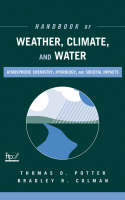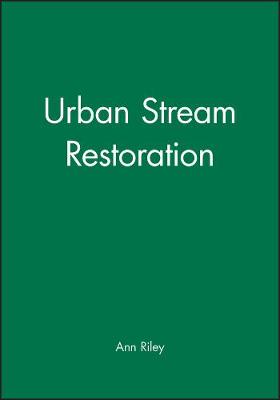Handbook of Weather, Climate, and Water
 -15%
portes grátis
-15%
portes grátis
Handbook of Weather, Climate, and Water
Atmospheric Chemistry, Hydrology, and Societal Impacts
Colman, Bradley R.; Potter, Thomas D.
John Wiley & Sons Inc
02/2003
1020
Dura
Inglês
9780471214892
15 a 20 dias
1282
SECTION I: ATMOSPHERIC CHEMISTRY.
1. OVERVIEW: ATMOSPHERIC CHEMISTRY (Jack Fishman).
1 Stratospheric Chemistry: Understanding the Ozone Layer.
2 Tropospheric Chemistry: A Complex Interaction of Biogeochemical Cycles.
3 Global Carbon Cycle.
4 Global Carbon Budget.
5 Atmospheric Chemistry within Global Carbon Cycle.
6 Carbon Monoxide, Nitrogen Oxides, and Oxidizing Capacity of Troposphere.
7 Atmospheric Chemistry and Global Warming.
8 Stratosphere-Troposphere Chemical and Climate Interaction.
9 Stratosphere-Trophosphere Exchange.
References.
2. OXIDIZING POWER OF ATMOSPHERE (Daniel J. Jacob).
1 Introduction.
2 Hydroxyl Radical OH.
3 Other Atmospheric Oxidants.
References.
3. TROPOSPHERIC OZONE (Jack Fishman).
1 Introduction.
2 Chemistry of Tropospheric Ozone Formation.
3 Global Distribution of Tropospheric Ozone.
4 Tropospheric Ozone Trends in Nonurban Troposphere.
5 Global Tropospheric Ozone Budget.
6 Current Understanding of Tropospheric Ozone Budget.
References.
4. NITROGEN OXIDES AND OTHER REACTIVE NITROGEN SPECIES (J. H. Crawford, J. D. Bradshaw, D. D. Davis, and S. C. Liu).
1 Introduction.
2 Chemical Transformations and Speciation of Reactive Nitrogen.
3 Sources of Reactive Nitrogen.
4 Tropospheric Distribution of Reactive Nitrogen.
References.
5. CARBON MONOXIDE IN THE ATMOSPHERE (Paul Novelli).
1 Measurement Techniques.
2 Global CO Distributions.
3 Global CO Budget.
4 Tropospheric Trends.
References.
6. ATMOSPHERIC METHANE (M. A. K. Khalil and M. J. Shearer).
1 Introduction.
2 Atmospheric Observations.
3 Mass Balance.
4 Sources and Sinks.
5 Past and Present Trends.
6 Discussion and Commentary.
References.
7. BIOGENIC NONMETHANE HYDROCARBONS (Marcy E. Litvak).
1 Introduction.
2 Biogenic NMVOCs.
3 Regional and Global Distribution of Biogenic NMVOC Emissions.
4 Summary and Conclusions.
References.
8. ATMOSPHERIC SULFUR (D. D. Davis, G. Chen, and M. Chin).
1 Introduction.
2 Chemical Forms, Sources, and Concentration Levels.
3 Transformations.
4 Global Distributions of SO2 and Sulfate.
5 Stratospheric Sulfur.
References.
9. CONVECTIVE TRANSPORT (Kenneth E. Pickering).
1 Introduction.
2 Observations.
3 Modeling.
4 Summary.
References.
10. BOUNDARY LAYER PROCESSES AND FLUX MEASUREMENTS (Donald H. Lenschow).
1 Introduction.
2 Boundary Layer Evolution.
3 Structure of the Boundary Layer.
4 Scales and Processes.
5 Observational Techniques.
References.
11. SOURCES AND COMPOSITION OF AEROSOL PARTICLES (Richard Arimoto).
1 Introduction.
2 Mechanically Generated Aerosols.
3 Sources Producing Primary and Secondary Particles.
4 Concluding Remarks.
References.
12. AEROSOLS: FORMATION AND MICROPHYSICS IN THE TROPOSPHERE (John H. Seinfeld).
1 Introduction.
2 Particle Size Distribution.
3 Residence Times of Particles in the Troposphere.
4 Tropospheric Aerosols.
5 Aerosol Microphysics.
6 Conclusion.
References.
13. PHOTOCHEMICAL SMOG: OZONE AND ITS PRECURSORS (Sanford Sillman).
1 Introduction.
2 General Features of Photochemical Smog.
3 Relation between Ozone, NOx, and Hydrocarbons.
4 Chemistry of Ozone Formation.
References.
14. BIOMASS BURNING (Anne M. Thompson).
1 Introduction.
2 Chemical Reactions: Ozone Formation and Effects of Fires on Atmospheric Oxidizing Capacity.
3 Results of Tropical Field Campaigns.
4 Remote Sensing.
References.
15. ACID RAIN AND DEPOSITION (William B. Grant).
1 Introduction.
2 Sources.
3 Transformation.
4 Transport.
5 Deposition.
6 Measurement.
7 Intensive Study Programs.
8 Global Trends in Emissions and Deposition.
9 Soil Changes.
10 Effects of Forests, Aquatic Ecosystems, and Materials.
11 Policies.
References.
16. FUNDAMENTALS OF VISIBILITY (William C. Malm).
1 Introduction.
2 Theory of Radiation Transfer and Visibility.
3 Visibility Impairment.
4 Examples of Visibility Impairment.
5 Value of Good Visual Air Quality.
References.
17 CLOUD CHEMISTRY (Stephen E. Schwartz).
1 Introduction.
2 Cloud Physical Properties Pertinent to Cloud Chemistry.
3 Sources of Cloudwater Composition.
4 Uptake of Gases into Cloudwater.
5 Reactive Uptake of Gases by Cloudwater.
6 Coupled Mass Transport of Chemical Reaction.
7 Summary.
References.
18. DRY DEPOSITION (M. L. Wesely).
1 Introduction.
2 Formulation of Deposition Velocity.
3 Deposition Velocity Estimates.
4 Models of Deposition Velocity.
References.
19. FATE OF ATMOSPHERIC TRACE GASES: WET DEPOSITION (Chris Walcek).
1 Introduction.
2 Nucleation Scavenging.
References.
20. LARGE-SCALE CIRCULATION OF THE STRATOSPHERE (William L. Grose).
1 Governing Equations.
2 Vertical Temperature Structure.
3 Zonal-Mean Climatology of Temperatures and Zonal Winds.
4 Zonal-Mean Meridonial Circulation.
5 Wave Motions.
6 Summary.
References.
21. STRATOSPHERIC OZONE OBSERVATIONS (Jack A. Kaye and Jack Fishman).
1 Introduction.
2 Properties of Ozone Affecting Its Measurement.
3 Total Column Measurements.
4 Ozone Vertical Profile Measurements.
5 Future Measurements.
References.
22. AEROSOL PROCESSES IN THE STRATOSPHERE (Mario J. Molina).
1 Introduction.
2 Chemical Reactions on Stratospheric Aerosols.
3 Heterogeneous Reaction Rates and Mechanisms.
4 Thermodynamic Properties of Stratospheric Aerosols.
5 Mechanism of Formation of Stratospheric Aerosols.
References.
SECTION 2: HYDROLOGY.
23. HYDROLOGY OVERVIEW (Soroosh Sorooshian and Martha P. L. Whitaker).
1 Introduction.
2 Hydrologic Cycle.
3 Reservoirs.
4 Fluxes.
5 Modeling and Remote Sensing of the Global Hydrologic Cycle: Modeling Globally, Benefiting Locally.
6 Stochastic Models of Hydrologic Processes.
7 Conclusion.
References.
24. RAINFALL (James A. Smith).
1 Rain Gages.
2 Radar.
3 Satellite.
References.
25. SNOW HYDROLOGY AND WATER RESOURCES (WESTERN UNITED STATES) (Roger C. Bales and Don Cline).
1 Introduction.
2 Current Hydroclimatic Conditions in the Western United States.
3 Measurement and Estimation of Snow Properties.
4 Estimation of Snowmelt Runoff.
References.
26. EVALUATING THE SPATIAL DISTRIBUTION OF EVAPORATION (William P. Kustas, M. Susan Moran, and John M. Norman).
1 Introduction.
2 Short History.
3 Conventional Approaches for Measuring Evaporation.
4 Approaches for Estimating Evaporation Using Remote Sensing.
5 Synthesis.
6 Concluding Remarks.
References.
27. INFILTRATION AND SOIL MOISTURE PROCESSES (Paul R. Houser).
1 Controls on Infiltration and Soil Moisture.
2 Principles of Soil Water Movement.
3 Infiltration Estimation.
4 Infiltration Measurement.
5 Soil Moisture Measurement.
6 Spatial and Temporal Variability.
References.
28. GROUNDWATER FLOW PROCESSES (William W-G. Yeh).
1 Introduction.
2 Darcy's Law.
3 Flow Equation for a Confined or Leaky Aquifer.
4 Flow Equation for an Unconfined Aquifer.
5 Initial and Boundary Conditions.
6 Data Collection.
7 Selection of Numerical Models.
8 Parameter Estimation (Parameter Identification).
9 Parameterization.
10 Parameter Uncertainty, Parameter Structure, and Optimum Parameter Dimension.
11 Model Structure Error (Parameter Structure Error).
12 Generalized Inverse Procedure.
13 Conclusions.
References.
29. SURFACE RUNOFF GENERATION (Keith Beven).
1 Introduction: Defining Runoff.
2 Generation of Subsurface Runoff.
3 Generation of Surface Runoff.
4 Effect of Heterogeneity.
5 Importance of Runoff in Grid-Scale Land Surface Modeling for GCMs.
References.
30. FLOW ROUTING (D. L. Fread).
1 Introduction.
2 Storage Routing Models.
3 Simplified Hydraulic Routing Models.
4 Dynamic Routing Model.
References.
31. HYDROLOGIC MODELING FOR RUNOFF FORECASTING (Hoshin Gupta).
1 Introduction.
2 Modeling and Complexity.
3 Model Parameter Estimation, Calibration, and Evaluation.
4 Forecasting and State Updating.
5 Emerging Directions.
32. STOCHASTIC CHARACTERISTICS AND MODELING OF HYDROCLIMATIC PROCESSES (Jose? D. Salas and Roger A. Pielke, Sr.).
1 Introduction.
2 General Characteristics of Hydroclimatic Processes.
3 Stochastic Analysis and Properties of Hydroclimatic Time Series.
4 Stochastic Models and Modeling Techniques.
References.
33. STOCHASTIC SIMULATION OF PRECIPITATION AND STREAMFLOW PROCESSES (Jose? D. Salas, Jorge A. Ramy?rez, Paolo Burlando, and Roger A. Pielke, Sr.).
1 Stochastic Simulation of Precipitation.
2 Stochastic Simulation of Streamflow.
3 Temporal and Spatial Disaggregation Models.
4 Temporal and Spatial Aggregation Models.
5 Scaling Issues and Downscaling.
References.
34. STOCHASTIC FORECASTING OF PRECIPITATION AND STREAMFLOW PROCESSES (Juan B. Valde? s, Paolo Burlando, and Jose? D. Salas).
1 Introduction.
2 Adaptive Prediction: The Kalman Filter.
3 Stochastic Precipitation Forecasting.
4 Stochastic Streamflow Forecasting.
References.
35. REMOTE SENSING AND GEOGRAPHICAL INFORMATION SYSTEMS APPLICATIONS IN HYDROLOGY (Edwin T. Engman and Nandish Mattikalli).
1 Introduction.
2 Precipitation.
3 Snow Hydrology.
4 Soil Moisture.
5 Evapotranspiration.
6 Runoff.
7 Water and Energy Balance Models.
8 Geographical Information Systems.
9 Summary and Conclusions.
References.
36. FLOODS (Steven Jennings and Eve Gruntfest).
1 Introduction.
2 Definition of Floods.
3 Factors That Lead to Flooding.
4 Discussion of Nonstructural Measures.
5 Conclusion.
References.
SECTION 3: SOCIETAL IMPACTS.
37. CLIMATE AND SOCIETY (Michael H. Glantz).
References.
38. HOUSEHOLD FOOD SECURITY AND COPING WITH CLIMATIC VARIABILITY IN DEVELOPING COUNTRIES (Thomas E. Downing and Yolande Stowell).
1 Introduction.
2 Case Studies of Vulnerability and Coping.
3 Approaches to Coping, Capacity, and Vulnerability.
4 Coping and Climate Prediction.
5 Conclusions.
References.
39. DROUGHT IN THE U.S. GREAT PLAINS (Donald A. Wilhite).
1 Introduction.
2 Concept of Drought: Definition and Types.
3 Drought Climatology of the Great Plains.
4 Impacts of Drought.
5 Drought Management.
6 Summary.
References.
40. FLOODS ON THE MISSISSIPPI RIVER SYSTEM OF THE UNITED STATES (Stanley A. Changnon).
1 Introduction.
2 Efforts to Control Flooding: 1851 to Present.
3 Impacts from Flooding.
4 Lessons.
5 Summary.
References.
42. HURRICANE AS AN EXTREME METEOROLOGICAL EVENT (Roger A. Pielke, Jr., and Roger A. Pielke, Sr.).
1 Introduction: Understanding Societal Responses to Extreme Weather Events.
2 Hurricanes Defined.
3 Hurricanes in North American History.
4 Geographic and Seasonal Distribution: Origin.
5 Hurricane Impacts on Ocean and Land.
6 Conclusion.
References.
43. EL NINO IN AUSTRALIA (Neville Nicholls).
1 Introduction.
2 El Nino-Southern Oscillation Effect on Australian Climate.
3 Discovery of Effect of El Nino-Southern Oscillation on Australia.
4 Ecological Impacts of El Nino-Southern Oscillation.
5 El Nino-Southern Oscillation and Vegetation Changes.
6 Impacts of El Nino-Southern Oscillation on Australian Crops.
References.
44. BIOLOGICAL AND SOCIETAL IMPACTS OF CLIMATE VARIABILITY: AN EXAMPLE FROM PERUVIAN FISHERIES (Kenneth Broad).
1 Introduction.
2 What Is ENSO?
3 Peruvian Fisheries Sector.
4 Artisanal Subsector.
5 Industrial Subsector.
6 Policy Implications of Climate Information.
References.
45. DROUGHT IN SOUTH AFRICA (Coleen Vogel).
1 Introduction.
2 Biophysical Dimensions of Drought in South Africa.
3 Rainfall Variability.
4 Causes of Droughts in South Africa.
References.
41. DROUGHT IN NORTHWEST AFRICA (Will Swearingen and Abdellatif Bencherifa).
1 Introduction.
2 Increasing Vulnerability to Drought.
3 Field Research to Assess Linkages between Human Activities and Drought.
4 Conclusion.
5 Classifying Droughts.
6 Impacts of Droughts in South Africa.
7 Drought Management and Policy Initiatives.
8 Conclusions.
References.
46. TRANSBOUNDARY FISHERIES: PACIFIC SALMON (Kathleen A. Miller and Mary W. Downton).
1 Introduction.
2 Salmon Abundance: Climate and Other Influences.
3 History of Harvest Management.
4 Recent Conflict.
5 Current Agreement and Prospects for the Future.
References.
47. TRANSBOUNDARY RIVER FLOW CHANGES (Roger S. Pulwarty).
1 Introduction.
2 Impacts.
3 The Nile: Centuries of Change.
4 The Colorado: Decadal-Scale Variations.
5 The Parana?-Paraguay River Basin: Interannual Variability and Extreme Events.
6 Problems.
7 Lessons.
8 Importance of Linking Human and Physical Aspects.
References.
48. LESSONS FROM THE RISING CASPIAN (Igor S. Zonn).
1 Introduction.
2 Nature of Sea-Level Changes in Caspian Sea.
3 The Caspian Rises.
4 Societal Impacts of Sea-Level Rise.
5 Sea-Level Change as a Global Problem.
References.
49. ACID RAIN AND SOCIETY (Paulette Middleton).
1 Introduction.
2 Acid Rain: The Phenomenon.
3 Definitions of Acid Rain.
4 Sources of Acidity.
5 Effects of Acid Rain.
6 Social Response to Acid Rain.
7 Current Conditions.
8 Keeping a Broad Basis of Assessment and Action.
References.
50. IMPACTS OF CLIMATE CHANGE (Stewart J. Cohen).
1 Science-Policy Challenge.
2 Need for Integrated Assessment of Global Climate Change.
3 Methodology for Impact Assessment of Climate Change Scenarios.
4 Summary of Case Studies.
5 Lessons and a Look Ahead.
References.
51. IMPACTS OF STRATOSPHERIC OZONE DEPLETION (Michele M. Betsill).
1 Introduction.
2 Impacts of Stratospheric Ozone Depletion.
3 International Responses to Stratospheric Ozone Depletion.
4 Remaining Challenges in Addressing Stratospheric Ozone Depletion.
5 Conclusion.
References.
52. TROPICAL DEFORESTATION AND CLIMATE (Roger A. Sedjo).
1 Introduction.
2 Human Influences in the Tropics.
3 Values of Forests.
4 Deforestation in the Tropics.
5 Similarities with Earlier Deforestations.
6 Timber Harvests in the Tropics.
7 Renewability.
8 Conclusions.
References.
53. DESERTIFICATION (R. L. Heathcote).
1 Introduction: Origins of Concern.
2 Defining the Phenomenon.
3 Documenting Desertification.
4 Explaining Desertification.
5 Future of Desertification.
References.
54. IMAGINABLE SURPRISES (Stephen H. Schneider).
1 Introduction.
2 Uncertainty.
3 Overcome or Just Manage Uncertainty.
4 Surprise.
5 Application to Global Change.
References.
Index.
SECTION I: ATMOSPHERIC CHEMISTRY.
1. OVERVIEW: ATMOSPHERIC CHEMISTRY (Jack Fishman).
1 Stratospheric Chemistry: Understanding the Ozone Layer.
2 Tropospheric Chemistry: A Complex Interaction of Biogeochemical Cycles.
3 Global Carbon Cycle.
4 Global Carbon Budget.
5 Atmospheric Chemistry within Global Carbon Cycle.
6 Carbon Monoxide, Nitrogen Oxides, and Oxidizing Capacity of Troposphere.
7 Atmospheric Chemistry and Global Warming.
8 Stratosphere-Troposphere Chemical and Climate Interaction.
9 Stratosphere-Trophosphere Exchange.
References.
2. OXIDIZING POWER OF ATMOSPHERE (Daniel J. Jacob).
1 Introduction.
2 Hydroxyl Radical OH.
3 Other Atmospheric Oxidants.
References.
3. TROPOSPHERIC OZONE (Jack Fishman).
1 Introduction.
2 Chemistry of Tropospheric Ozone Formation.
3 Global Distribution of Tropospheric Ozone.
4 Tropospheric Ozone Trends in Nonurban Troposphere.
5 Global Tropospheric Ozone Budget.
6 Current Understanding of Tropospheric Ozone Budget.
References.
4. NITROGEN OXIDES AND OTHER REACTIVE NITROGEN SPECIES (J. H. Crawford, J. D. Bradshaw, D. D. Davis, and S. C. Liu).
1 Introduction.
2 Chemical Transformations and Speciation of Reactive Nitrogen.
3 Sources of Reactive Nitrogen.
4 Tropospheric Distribution of Reactive Nitrogen.
References.
5. CARBON MONOXIDE IN THE ATMOSPHERE (Paul Novelli).
1 Measurement Techniques.
2 Global CO Distributions.
3 Global CO Budget.
4 Tropospheric Trends.
References.
6. ATMOSPHERIC METHANE (M. A. K. Khalil and M. J. Shearer).
1 Introduction.
2 Atmospheric Observations.
3 Mass Balance.
4 Sources and Sinks.
5 Past and Present Trends.
6 Discussion and Commentary.
References.
7. BIOGENIC NONMETHANE HYDROCARBONS (Marcy E. Litvak).
1 Introduction.
2 Biogenic NMVOCs.
3 Regional and Global Distribution of Biogenic NMVOC Emissions.
4 Summary and Conclusions.
References.
8. ATMOSPHERIC SULFUR (D. D. Davis, G. Chen, and M. Chin).
1 Introduction.
2 Chemical Forms, Sources, and Concentration Levels.
3 Transformations.
4 Global Distributions of SO2 and Sulfate.
5 Stratospheric Sulfur.
References.
9. CONVECTIVE TRANSPORT (Kenneth E. Pickering).
1 Introduction.
2 Observations.
3 Modeling.
4 Summary.
References.
10. BOUNDARY LAYER PROCESSES AND FLUX MEASUREMENTS (Donald H. Lenschow).
1 Introduction.
2 Boundary Layer Evolution.
3 Structure of the Boundary Layer.
4 Scales and Processes.
5 Observational Techniques.
References.
11. SOURCES AND COMPOSITION OF AEROSOL PARTICLES (Richard Arimoto).
1 Introduction.
2 Mechanically Generated Aerosols.
3 Sources Producing Primary and Secondary Particles.
4 Concluding Remarks.
References.
12. AEROSOLS: FORMATION AND MICROPHYSICS IN THE TROPOSPHERE (John H. Seinfeld).
1 Introduction.
2 Particle Size Distribution.
3 Residence Times of Particles in the Troposphere.
4 Tropospheric Aerosols.
5 Aerosol Microphysics.
6 Conclusion.
References.
13. PHOTOCHEMICAL SMOG: OZONE AND ITS PRECURSORS (Sanford Sillman).
1 Introduction.
2 General Features of Photochemical Smog.
3 Relation between Ozone, NOx, and Hydrocarbons.
4 Chemistry of Ozone Formation.
References.
14. BIOMASS BURNING (Anne M. Thompson).
1 Introduction.
2 Chemical Reactions: Ozone Formation and Effects of Fires on Atmospheric Oxidizing Capacity.
3 Results of Tropical Field Campaigns.
4 Remote Sensing.
References.
15. ACID RAIN AND DEPOSITION (William B. Grant).
1 Introduction.
2 Sources.
3 Transformation.
4 Transport.
5 Deposition.
6 Measurement.
7 Intensive Study Programs.
8 Global Trends in Emissions and Deposition.
9 Soil Changes.
10 Effects of Forests, Aquatic Ecosystems, and Materials.
11 Policies.
References.
16. FUNDAMENTALS OF VISIBILITY (William C. Malm).
1 Introduction.
2 Theory of Radiation Transfer and Visibility.
3 Visibility Impairment.
4 Examples of Visibility Impairment.
5 Value of Good Visual Air Quality.
References.
17 CLOUD CHEMISTRY (Stephen E. Schwartz).
1 Introduction.
2 Cloud Physical Properties Pertinent to Cloud Chemistry.
3 Sources of Cloudwater Composition.
4 Uptake of Gases into Cloudwater.
5 Reactive Uptake of Gases by Cloudwater.
6 Coupled Mass Transport of Chemical Reaction.
7 Summary.
References.
18. DRY DEPOSITION (M. L. Wesely).
1 Introduction.
2 Formulation of Deposition Velocity.
3 Deposition Velocity Estimates.
4 Models of Deposition Velocity.
References.
19. FATE OF ATMOSPHERIC TRACE GASES: WET DEPOSITION (Chris Walcek).
1 Introduction.
2 Nucleation Scavenging.
References.
20. LARGE-SCALE CIRCULATION OF THE STRATOSPHERE (William L. Grose).
1 Governing Equations.
2 Vertical Temperature Structure.
3 Zonal-Mean Climatology of Temperatures and Zonal Winds.
4 Zonal-Mean Meridonial Circulation.
5 Wave Motions.
6 Summary.
References.
21. STRATOSPHERIC OZONE OBSERVATIONS (Jack A. Kaye and Jack Fishman).
1 Introduction.
2 Properties of Ozone Affecting Its Measurement.
3 Total Column Measurements.
4 Ozone Vertical Profile Measurements.
5 Future Measurements.
References.
22. AEROSOL PROCESSES IN THE STRATOSPHERE (Mario J. Molina).
1 Introduction.
2 Chemical Reactions on Stratospheric Aerosols.
3 Heterogeneous Reaction Rates and Mechanisms.
4 Thermodynamic Properties of Stratospheric Aerosols.
5 Mechanism of Formation of Stratospheric Aerosols.
References.
SECTION 2: HYDROLOGY.
23. HYDROLOGY OVERVIEW (Soroosh Sorooshian and Martha P. L. Whitaker).
1 Introduction.
2 Hydrologic Cycle.
3 Reservoirs.
4 Fluxes.
5 Modeling and Remote Sensing of the Global Hydrologic Cycle: Modeling Globally, Benefiting Locally.
6 Stochastic Models of Hydrologic Processes.
7 Conclusion.
References.
24. RAINFALL (James A. Smith).
1 Rain Gages.
2 Radar.
3 Satellite.
References.
25. SNOW HYDROLOGY AND WATER RESOURCES (WESTERN UNITED STATES) (Roger C. Bales and Don Cline).
1 Introduction.
2 Current Hydroclimatic Conditions in the Western United States.
3 Measurement and Estimation of Snow Properties.
4 Estimation of Snowmelt Runoff.
References.
26. EVALUATING THE SPATIAL DISTRIBUTION OF EVAPORATION (William P. Kustas, M. Susan Moran, and John M. Norman).
1 Introduction.
2 Short History.
3 Conventional Approaches for Measuring Evaporation.
4 Approaches for Estimating Evaporation Using Remote Sensing.
5 Synthesis.
6 Concluding Remarks.
References.
27. INFILTRATION AND SOIL MOISTURE PROCESSES (Paul R. Houser).
1 Controls on Infiltration and Soil Moisture.
2 Principles of Soil Water Movement.
3 Infiltration Estimation.
4 Infiltration Measurement.
5 Soil Moisture Measurement.
6 Spatial and Temporal Variability.
References.
28. GROUNDWATER FLOW PROCESSES (William W-G. Yeh).
1 Introduction.
2 Darcy's Law.
3 Flow Equation for a Confined or Leaky Aquifer.
4 Flow Equation for an Unconfined Aquifer.
5 Initial and Boundary Conditions.
6 Data Collection.
7 Selection of Numerical Models.
8 Parameter Estimation (Parameter Identification).
9 Parameterization.
10 Parameter Uncertainty, Parameter Structure, and Optimum Parameter Dimension.
11 Model Structure Error (Parameter Structure Error).
12 Generalized Inverse Procedure.
13 Conclusions.
References.
29. SURFACE RUNOFF GENERATION (Keith Beven).
1 Introduction: Defining Runoff.
2 Generation of Subsurface Runoff.
3 Generation of Surface Runoff.
4 Effect of Heterogeneity.
5 Importance of Runoff in Grid-Scale Land Surface Modeling for GCMs.
References.
30. FLOW ROUTING (D. L. Fread).
1 Introduction.
2 Storage Routing Models.
3 Simplified Hydraulic Routing Models.
4 Dynamic Routing Model.
References.
31. HYDROLOGIC MODELING FOR RUNOFF FORECASTING (Hoshin Gupta).
1 Introduction.
2 Modeling and Complexity.
3 Model Parameter Estimation, Calibration, and Evaluation.
4 Forecasting and State Updating.
5 Emerging Directions.
32. STOCHASTIC CHARACTERISTICS AND MODELING OF HYDROCLIMATIC PROCESSES (Jose? D. Salas and Roger A. Pielke, Sr.).
1 Introduction.
2 General Characteristics of Hydroclimatic Processes.
3 Stochastic Analysis and Properties of Hydroclimatic Time Series.
4 Stochastic Models and Modeling Techniques.
References.
33. STOCHASTIC SIMULATION OF PRECIPITATION AND STREAMFLOW PROCESSES (Jose? D. Salas, Jorge A. Ramy?rez, Paolo Burlando, and Roger A. Pielke, Sr.).
1 Stochastic Simulation of Precipitation.
2 Stochastic Simulation of Streamflow.
3 Temporal and Spatial Disaggregation Models.
4 Temporal and Spatial Aggregation Models.
5 Scaling Issues and Downscaling.
References.
34. STOCHASTIC FORECASTING OF PRECIPITATION AND STREAMFLOW PROCESSES (Juan B. Valde? s, Paolo Burlando, and Jose? D. Salas).
1 Introduction.
2 Adaptive Prediction: The Kalman Filter.
3 Stochastic Precipitation Forecasting.
4 Stochastic Streamflow Forecasting.
References.
35. REMOTE SENSING AND GEOGRAPHICAL INFORMATION SYSTEMS APPLICATIONS IN HYDROLOGY (Edwin T. Engman and Nandish Mattikalli).
1 Introduction.
2 Precipitation.
3 Snow Hydrology.
4 Soil Moisture.
5 Evapotranspiration.
6 Runoff.
7 Water and Energy Balance Models.
8 Geographical Information Systems.
9 Summary and Conclusions.
References.
36. FLOODS (Steven Jennings and Eve Gruntfest).
1 Introduction.
2 Definition of Floods.
3 Factors That Lead to Flooding.
4 Discussion of Nonstructural Measures.
5 Conclusion.
References.
SECTION 3: SOCIETAL IMPACTS.
37. CLIMATE AND SOCIETY (Michael H. Glantz).
References.
38. HOUSEHOLD FOOD SECURITY AND COPING WITH CLIMATIC VARIABILITY IN DEVELOPING COUNTRIES (Thomas E. Downing and Yolande Stowell).
1 Introduction.
2 Case Studies of Vulnerability and Coping.
3 Approaches to Coping, Capacity, and Vulnerability.
4 Coping and Climate Prediction.
5 Conclusions.
References.
39. DROUGHT IN THE U.S. GREAT PLAINS (Donald A. Wilhite).
1 Introduction.
2 Concept of Drought: Definition and Types.
3 Drought Climatology of the Great Plains.
4 Impacts of Drought.
5 Drought Management.
6 Summary.
References.
40. FLOODS ON THE MISSISSIPPI RIVER SYSTEM OF THE UNITED STATES (Stanley A. Changnon).
1 Introduction.
2 Efforts to Control Flooding: 1851 to Present.
3 Impacts from Flooding.
4 Lessons.
5 Summary.
References.
42. HURRICANE AS AN EXTREME METEOROLOGICAL EVENT (Roger A. Pielke, Jr., and Roger A. Pielke, Sr.).
1 Introduction: Understanding Societal Responses to Extreme Weather Events.
2 Hurricanes Defined.
3 Hurricanes in North American History.
4 Geographic and Seasonal Distribution: Origin.
5 Hurricane Impacts on Ocean and Land.
6 Conclusion.
References.
43. EL NINO IN AUSTRALIA (Neville Nicholls).
1 Introduction.
2 El Nino-Southern Oscillation Effect on Australian Climate.
3 Discovery of Effect of El Nino-Southern Oscillation on Australia.
4 Ecological Impacts of El Nino-Southern Oscillation.
5 El Nino-Southern Oscillation and Vegetation Changes.
6 Impacts of El Nino-Southern Oscillation on Australian Crops.
References.
44. BIOLOGICAL AND SOCIETAL IMPACTS OF CLIMATE VARIABILITY: AN EXAMPLE FROM PERUVIAN FISHERIES (Kenneth Broad).
1 Introduction.
2 What Is ENSO?
3 Peruvian Fisheries Sector.
4 Artisanal Subsector.
5 Industrial Subsector.
6 Policy Implications of Climate Information.
References.
45. DROUGHT IN SOUTH AFRICA (Coleen Vogel).
1 Introduction.
2 Biophysical Dimensions of Drought in South Africa.
3 Rainfall Variability.
4 Causes of Droughts in South Africa.
References.
41. DROUGHT IN NORTHWEST AFRICA (Will Swearingen and Abdellatif Bencherifa).
1 Introduction.
2 Increasing Vulnerability to Drought.
3 Field Research to Assess Linkages between Human Activities and Drought.
4 Conclusion.
5 Classifying Droughts.
6 Impacts of Droughts in South Africa.
7 Drought Management and Policy Initiatives.
8 Conclusions.
References.
46. TRANSBOUNDARY FISHERIES: PACIFIC SALMON (Kathleen A. Miller and Mary W. Downton).
1 Introduction.
2 Salmon Abundance: Climate and Other Influences.
3 History of Harvest Management.
4 Recent Conflict.
5 Current Agreement and Prospects for the Future.
References.
47. TRANSBOUNDARY RIVER FLOW CHANGES (Roger S. Pulwarty).
1 Introduction.
2 Impacts.
3 The Nile: Centuries of Change.
4 The Colorado: Decadal-Scale Variations.
5 The Parana?-Paraguay River Basin: Interannual Variability and Extreme Events.
6 Problems.
7 Lessons.
8 Importance of Linking Human and Physical Aspects.
References.
48. LESSONS FROM THE RISING CASPIAN (Igor S. Zonn).
1 Introduction.
2 Nature of Sea-Level Changes in Caspian Sea.
3 The Caspian Rises.
4 Societal Impacts of Sea-Level Rise.
5 Sea-Level Change as a Global Problem.
References.
49. ACID RAIN AND SOCIETY (Paulette Middleton).
1 Introduction.
2 Acid Rain: The Phenomenon.
3 Definitions of Acid Rain.
4 Sources of Acidity.
5 Effects of Acid Rain.
6 Social Response to Acid Rain.
7 Current Conditions.
8 Keeping a Broad Basis of Assessment and Action.
References.
50. IMPACTS OF CLIMATE CHANGE (Stewart J. Cohen).
1 Science-Policy Challenge.
2 Need for Integrated Assessment of Global Climate Change.
3 Methodology for Impact Assessment of Climate Change Scenarios.
4 Summary of Case Studies.
5 Lessons and a Look Ahead.
References.
51. IMPACTS OF STRATOSPHERIC OZONE DEPLETION (Michele M. Betsill).
1 Introduction.
2 Impacts of Stratospheric Ozone Depletion.
3 International Responses to Stratospheric Ozone Depletion.
4 Remaining Challenges in Addressing Stratospheric Ozone Depletion.
5 Conclusion.
References.
52. TROPICAL DEFORESTATION AND CLIMATE (Roger A. Sedjo).
1 Introduction.
2 Human Influences in the Tropics.
3 Values of Forests.
4 Deforestation in the Tropics.
5 Similarities with Earlier Deforestations.
6 Timber Harvests in the Tropics.
7 Renewability.
8 Conclusions.
References.
53. DESERTIFICATION (R. L. Heathcote).
1 Introduction: Origins of Concern.
2 Defining the Phenomenon.
3 Documenting Desertification.
4 Explaining Desertification.
5 Future of Desertification.
References.
54. IMAGINABLE SURPRISES (Stephen H. Schneider).
1 Introduction.
2 Uncertainty.
3 Overcome or Just Manage Uncertainty.
4 Surprise.
5 Application to Global Change.
References.
Index.













